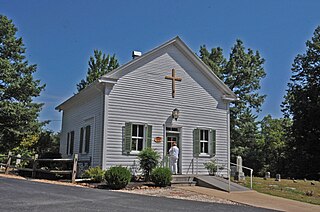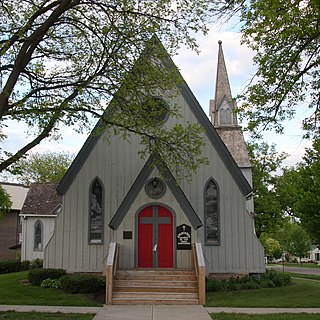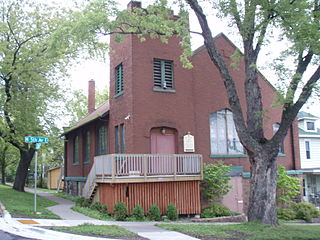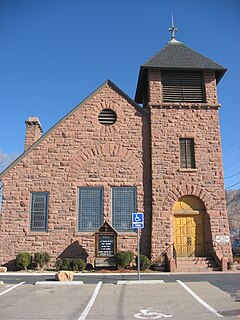St. Paul United Methodist Church is located in the historic Grant Park neighborhood of Atlanta, Georgia. For a time in the early 1900s, St. Paul had the largest Methodist congregation in the Southeastern United States. The church organ was acquired at the Cotton States Exhibition in 1887. St. Paul's stained glass windows, which date back to 1907, are being refurbished. St. Paul is a main stop on tours of the Grant Park neighborhood given by the Atlanta Preservation Center. St. Paul is also home to the Grant Park Cooperative Preschool. St. Paul, the Grant Park Cooperative Preschool and the Grant Park Parent Network host the annual Grant Park Candlelight Tour of Homes, which also includes an artist marketplace and a Winter Wonderland for children. The Candlelight Tour of Homes begins at St. Paul.

The St. Paul A.M.E. Church is a historic American Gothic Revival style African Methodist Episcopal Church located in Raleigh, North Carolina. A red brick and frame structure built in 1884 by black masons, St. Paul's was the first independent congregation of African Americans in Raleigh and is the oldest African-American church in Wake County, North Carolina. Before the end of the Civil War, the future founders of St. Paul's had been slave members of the Edenton Street United Methodist Church. The members of the church began calling their congregation "St. Paul's" in 1848. The church was listed on the National Register of Historic Places in November 1987 and is also a Raleigh Historic Landmark.

The First Baptist Church of St. Paul is an historic church building in Saint Paul, Minnesota, United States. The original steeple, which rose 145 feet (44 m) above the ground, was removed in 1945. The stone base was sinking into the marshy soil and causing structural strain on the rest of the building. A new, shorter steeple was erected, but without the belfry and clock that the original steeple had.

Charles Street African Methodist Episcopal Church is an historic African Methodist Episcopal Church at 551 Warren Street in Boston, Massachusetts. The current church building was built in 1888 by J. Williams Beal and added to the National Register of Historic Places in 1983.

Built in 1912, the First Presbyterian Church of Redmond is the oldest standing church structure in the city of Redmond, Oregon, United States. It is also the second-oldest religious building in Deschutes County. The church was built in the Gothic Revival style with Queen Anne architectural detailing. It was the home of Protestant congregations from 1912 until 1979. Today, the building is privately owned and used as a special events venue. The First Presbyterian Church of Redmond was listed on the National Register of Historic Places in 2001.

The Mechanicsburg Baptist Church is a historic church in the village of Mechanicsburg, Ohio, United States. Constructed for a Methodist congregation in the late nineteenth century, the building was taken over by Baptists after the original occupants vacated it, and it has been named a historic site.

Hedges Chapel is a historic non-denominational chapel located at 668 Mountain Lake Road in Hedgesville, Berkeley County, West Virginia. It was built in 1850 and is a 1-story, three-by-two-bay, gable-roofed log building on a fieldstone foundation. It is sheathed in German siding, added in 1885 and topped by a corrugated metal roof. Also on the property is the church cemetery, with approximately 100 burials dating to 1872.

First Presbyterian Church is a historic church at 213 Main Street in Clarksville, Tennessee. The congregation is currently affiliated with the Presbyterian Church (USA).

Emmaus United Methodist Church, originally built as Calvary Methodist Episcopal Church, two of five names it has gone by in its existence, is located at Morris and West Lawrence streets in Albany, New York, United States. It is a brick Collegiate Gothic building constructed in the early 20th century. In 2008 it was listed on the National Register of Historic Places.

Methodist Episcopal Church is a historic Methodist church at Fort and N. Adams Streets in Buffalo, Wyoming, United States. The church was built in 1899, and was added to the National Register in 1976. It is located at the corner of Adams Avenue and Fort Street in Buffalo, Wyoming.

The Bethel A.M.E. Church, known in its early years as Indianapolis Station or the Vermont Street Church, is a historic African Methodist Episcopal Church in Indianapolis, Indiana. Organized in 1836, it is the city's oldest African-American congregation. The three-story church on West Vermont Street dates to 1869 and was added to the National Register in 1991. The surrounding neighborhood, once the heart of downtown Indianapolis's African American community, significantly changed with post-World War II urban development that included new hotels, apartments, office space, museums, and the Indiana University–Purdue University at Indianapolis campus. In 2016 the congregation sold their deteriorating church, which will be used in a future commercial development. The congregation built a new worship center at 6417 Zionsville Road in Pike Township, Marion County, Indiana.

The Casstown Lutheran Stone Church is a historic former church building in the village of Casstown, Ohio, United States. Built in the late 1830s, it was home to one of the region's earliest Lutheran congregations for just a short time before being converted for profane use. Its solid stone construction has made it architecturally important, and it has been named a historic site.

Church of the Good Shepherd Episcopal is a historic church at Moore and 8th Streets in Blue Earth, Minnesota. The city of Blue Earth was established in 1856, and although most of its early settlers were Methodists, Episcopalians and Presbyterians also arrived in the city. The first Episcopal service in the city was held in the Presbyterian church in town on December 10, 1867. In 1870, Bishop Henry Whipple asked the Reverend Solomon Stephens Burleson to visit the city and consider serving the Episcopal community as its resident pastor. Whipple and Burleson returned in 1871, and Whipple offered the parish $3000 for construction of a church if the parish would pay for the rectory. The parish accepted the offer, and Burleson moved from his parish in Northfield to establish the church. Burleson designed the building himself. It has a rectangular shape, with a steeply-pitched roof. A tower topped with a shingled steeple is located on one side of the building. Construction was completed on March 21, 1872, and Whipple returned to consecrate the building on August 13, 1872.

St. Mark's African Methodist Episcopal Church is a historic African Methodist Episcopal (AME) church in Duluth, Minnesota, United States. St. Mark's has played a central role in Duluth's African American community for over 125 years. While other black organizations have dissolved or moved to the Minneapolis–Saint Paul area, St. Mark's has been a local mainstay.

The German Methodist Episcopal Church, also known as St. Paul's German Methodist Episcopal Church, is a historic church building in Burlington, Iowa, United States. The German Methodist Episcopal Church was organized in Burlington in 1845. It was the second of eight German congregations established in the city of various denominations. The Reverend Sebastian Barth, the first pastor, initially held services in a small frame house, and then in the basement of another church. The first permanent home for the congregation was a small brick church that was built in 1848. This structure was built from 1868 to 1869. It is a Victorian Gothic structure with Romanesque elements. The stone for the exterior was quarried from the site where the church was built.

St. Paul's Methodist Protestant Church, also known as Stone Church, is a church building located south of Culbertson, Nebraska, United States, on Nebraska Highway 17. It was built in 1900 and was added to the National Register in 1979.

The Old Stone Congregational Church, also known as the First Congregational Church of Lyons, is a historic church in Lyons, Colorado, built in 1894-5 and listed on the National Register of Historic Places in 1976.

The First United Methodist Church is a Methodist church that was founded in 1868 in Reno, Nevada. In 1868 the first meetings were held in the local schoolhouse on the corner of what is now First and Sierra Streets. In 1871 The first church was erected and dedicated on Sierra Street between First and Second Streets. In the early 1900s the wood framed church was moved to the back of the lot and a new brick building was added to it. And finally in 1925 plans for a new building were made. Designed by Wythe, Blaken, and Olson of Oakland, the church is one of the first poured concrete buildings in Reno and utilizes Gothic Revival architectural themes. The corner stone for the current historical building was placed in 1926, with the building being dedicated in December of that same year. It was listed on the National Register of Historic Places in 1983; the listing included two contributing buildings. The second building is a parish house designed by local architect Donald Parsons and built in c.1840. In 1965 another addition was done to add on what is currently the fellowship hall, and Sunday school class rooms.

The Elk Rapids First Methodist Episcopal Church is a former church located at 301 Traverse Street in Elk Rapids, Michigan. The building now houses Elk Rapids Area Historical Museum. It was listed on the National Register of Historic Places in 2015.

St. James United Methodist Church is located in Cedar Rapids, Iowa, United States. The congregation began as a Sunday school in the northwest part of the city organized by Trinity Methodist Episcopal Church. The evangelist Billy Sunday had preached a revival there and over 300 people joined the church. St. James Methodist Episcopal Church, as it was then known, was established shortly afterward in February 1910. The congregation originally used the closed Danish Lutheran Church at K Avenue NW and Fourth Street NW for their services, and they moved the building that summer to Ellis Boulevard NW. St. James grew to the point that a new building was needed. In 1945 property across the street was purchased, and local architect William J. Brown designed the new church facility. Construction began in September 1952 and it was completed in April 1954 for $165,000.





















